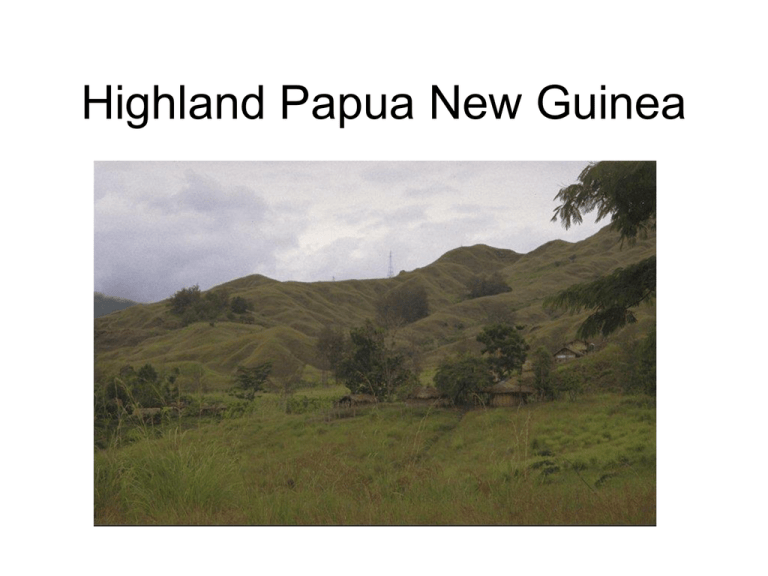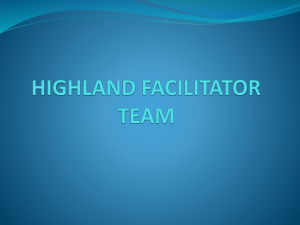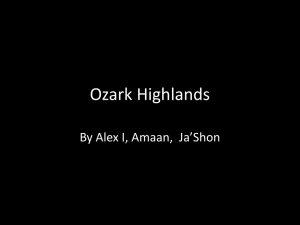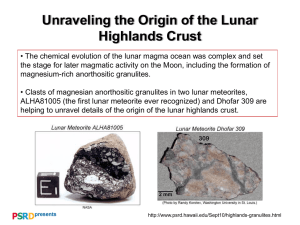Highland Papua New Guinea
advertisement

Highland Papua New Guinea - PNG is divided into four regions (Highlands, Islands, Momase and Papua Regions) and these into a total of 20 Provinces - the Highland Region is composed of five provinces: Area in km2 Simbu (2 on map) Population* 6 100 259 703 Eastern Highlands (3) 11 200 432 972 Enga (6) 12 800 295,031 Southern Highlands (15) 23 800 546,265 Western Highlands (17) 8 500 440 025 Total: 1 973 996 (out of 5,670,544) * According to the census in 2000. Note: the census is said to be unreliable and there is considerable variation between different sources Basic geographical facts: - The Highland region is composed of a long string of valleys separated by mountains - Highest regions receive snowfall, which is unsual in the tropics - the highest mountain is Mt. Wilhelm (4 509 metres, located at the intersection of Simbu, Western Highland and Madang provinces) - Enga is the highest province with altitudes of about 2000 metres - Major rivers: - Enga valleys form the watershed for two river systems, the Lagaiap and the Lai, which are tributaries of the major rivers Fly and Sepik - Putari river (flows through Mendi (capital of Southern Highlands pr.) ) - Strickland (flows from Wabag (capital of Enga) into the Fly river) Basic geographical facts: urban centres - Kundiawa (capital of Simbu): population about 5000 Goroka (capital of Eastern Highlands): population about 25 000 - - home of several national institutes, for example The University of Goroka and the PNG Instute of Medical Research Wabag (capital of Enga): population about 3 300 Mendi (capital of Southern Highlands): n/a Mount Hagen (capital of Western Highlands): population about 40 000 - third largest city in PNG Demographic facts: - Papua New Guinea is ethnically and linguistically a very diverse country - Over 850 indigenious languages are spoken and there are at least as many traditional societies, with only about 7000 speakers per language on the avarage - note: only Vanuatu has a higher language density - - This applies also for the Highlands region Major languages: - Tok pisin: creole language and the lingua franca of PNG Enga: both a linguistic and ethnic group - Enga is a unique case in the PNG, since it is the only major group in the province - other minor ethnic groups in the Enga province are the Ipili and Nete speakers - Other languages and ethnic groups: - Melpa (Western HL), Huli (Southern HL), Wiru (Southern HL), Kuman (Simbu)*, etc. *Trivia: The term "Simbu" comes from the Kuman language and mean roughly translated: "Thank you!" History - oldest human remains found in PNG are ca. 50 000 years old and the colonisation is assumed to have happened some 60 000 years ago agriculture invented independently ca. 9 000 years ago - traces of drainage ditches found at the sc. Kuk site in the interior Highlands possibly for cultivating taro (Colocasia esculenta) skilled techniques of agriculture: adapted to high population density, hilly terrain, frost, heavy rain and earthquakes - indigenous crops: sugarcane, Pacific bananas, yams, taro, sago and pandanus - followed later by the sweet potato (Ipomoea batatas) in the 17th century - - tropical horticulture or permaculture silviculture - deliberate planting of a native ironwood tree (Casuarina oligodon) ironwood sweet potato taro History: colonial adventures - - first Europeans to come to PNG were Spanish or Portuguese navigators in the 16th century formal colonisation by the British in various stages from 1883 and placement under the Australian Commonwealth in 1902 Germany colonised the northeast quarter of the island in 1884, during WWI Australia occupied it and held it until 1921 under Australian administration until independence in 1975, with the exception of WWII during which the island was occupied by the Japanese (1941-45) however: the Highlands remained largely unexplored up until the 1930's - 1933 Leahy brothers find the Wahgi valley in Western Highlands Economy: agriculture - agriculture supports the majority of the Highlands population (80-85% of the whole population of PNG) subsistence farming, i.e. farmers produce enough for themselves to subsist, but not products for the market pig-keeping important, both economically and culturally - - exchange of pigs in compensation and bridewealth payments and in large festivals, such as the Melpa moka or the Enga tee today also cash-cropping, the most important cash crops being coffee and tea Economy: mining - PNG is very rich in natural resources, especially minerals - - these, most notably oil, gold and copper account for 72% of the export earnings and 26.3 % of the GDP remember: first Europeans in the Highlands were gold prospectors besides of being a major contributor to the GDP, mining is also a big source of both environmental and social problems - case: Porgera mine in the Enga province - operated since 1990 by a group of companies called Porgera Joint Venture - release of (treated) waste directly into the Lagaip river system (which flows into Strickland river) - the waste has according to environmental organisations negative effects on fish stocks, water plants and community health on large area along the rivers - deaths in the mine area have lead the local landowners to call for the closure of the mine in 2005 until deaths are properly investigated Porgera mine B&W photos (c) Jerry Jacka Further reading: Classics, ceremonial exchange & warfare: Meggit, Mervyn,1969: Pigs, Pearlshells and Women: Marriage in the New Guinea Highlands. Englewood Cliffs (NJ): Prentice Hall Meggit, Mervyn, 1977: Blood is Their Argument: Warfare among the Mae Enga Tribesmen of the New Guinea Highlands. Mountain View (CA): Mayfield Strathern, Andrew, 1971: The Rope of Moka: Big-men and Ceremonial Exchange in Mount Hagen, New Guinea. Cambridge: Cambridge UP Strathern, Andrew & Strathern, Marilyn, 1971: Self-Decoration in Mount Hagen. Toronto London: University of Toronto Press Environment and current issues: Diamond, Jared, 2005: Collapse: How Societies Choose to Fail or Succeed. New York: Viking Strathern, A. & Stewart, P., 2000: Arrow Talk: Transaction, Transition and Contradiction in New Guinea Highlands Society. Kent (OH): Kent UP West, Paige: "Environmental Conservation and Mining: Between Experience and Expectation in the Eastern Highlands of Papua New Guinea", The Contemporary Pacific 18.2 (2006) 295-313







